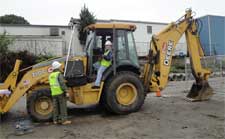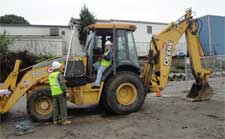 KINGSTON, R.I. – October 19, 2011 — A one-mile road construction project beneath Route 195 in East Providence is being used by students at the University of Rhode Island to gauge the cost and effectiveness of various methods of reducing diesel emissions from construction vehicles.
KINGSTON, R.I. – October 19, 2011 — A one-mile road construction project beneath Route 195 in East Providence is being used by students at the University of Rhode Island to gauge the cost and effectiveness of various methods of reducing diesel emissions from construction vehicles.
A collaboration between URI and the Rhode Island Department of Transportation, the DOT-funded project is designed to provide information that will help the state of Rhode Island determine the most effective approaches to meeting new emission standards.
“This is a great opportunity to determine the best way to meet the requirements of the new Diesel Emissions Reduction Act,” said RIDOT Director Michael P. Lewis.
According to URI graduate student Dean Valentini, who is conducting the diesel emission testing and helping to write the new standards, diesel engine emissions produce a great deal of air pollution and have been cited as key factors in a wide range of health issues, including respiratory and cardiac illnesses. Because of their larger engine size and less stringent regulations in the past, construction equipment may produce significantly more emissions than other diesel engines.
“We’re trying to profile the average construction site and gather data on what retrofits work best on what pieces of equipment,” said Valentini, a resident of Narragansett. “Our data will be used by contractors looking to see how to retrofit their vehicles.”
The URI Outreach Center was awarded a grant from the transportation department to evaluate the emissions from Cardi Construction Co. vehicles working on the Waterfront Drive road-building project, between Warren Ave. and Dexter Rd. in East Providence, where an industrial park is being expanded.
“The Department of Transportation asked URI to help them create a road map for cost-effective reduction of emissions statewide,” explained Outreach Center Director Marion Gold. “This initiative will provide the data RIDOT needs to control air pollution from future construction projects.”
Every vehicle that operates at greater than 50 horsepower and that will be on site for more than 30 days will have a 3-4 week assessment of its emissions before and after being retrofitted with pollution reduction equipment. The vehicles involved include excavators, backhoes, dump trucks, pavers and front-end loaders.
In addition to collecting data on the equipment, Valentini and URI undergraduate student Jacob Guilbert of Charlestown are surveying the equipment operators to get their insights about the performance of the vehicles and other issues before and after the retrofits. Both students are URI Energy Fellows, a program that provides them with hands-on experience addressing energy issues through formal research and applied outreach efforts.
“Everyone has been tremendously helpful and cooperative, from the project superintendent to the equipment operators,” Valentini said. “The Cardi vehicles are getting free retrofits for participating in the project, courtesy of DOT, so they’ll already be ready for the new emission standards.”
According to Valentini, the cheapest and least effective retrofits cost from $600 to $1200 per vehicle, with mid-range retrofits costing from $1200 to $3000 to install. The most effective retrofits, which reduce emissions by 80 to 90 percent, can cost up to $25,000 per vehicle.
A final report on the project will be provided to the R.I. Department of Transportation late next year.
Pictured above
URI student Dean Valentini (right) conducts emissions tests of a backhoe at an East Providence road construction site.

